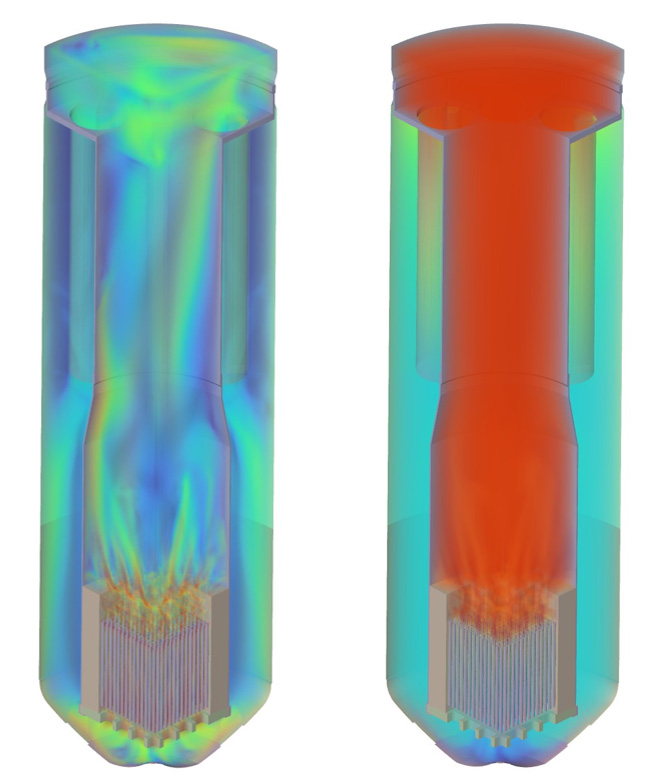Small nuclear power plants generating emission-free energy may soon heat Finnish homes – pilot plant will help demonstrate safety
Finnish startup company Steady Energy will test a small nuclear reactor test facility in Helsinki’s Salmisaari in the coming years.
If all goes according to plans, small nuclear power plants will begin appearing in Finnish residential areas in the coming years. The energy generated by a single 300-megawatt plant will be sufficient to meet the heating needs of up to 180,000 residents.
“One module of a small nuclear power plant is about the size of a shipping container, and one to six of them can be placed in a power plant,” says Antti Teräsvirta, Head of Process Engineering at Steady Energy, a Finnish technology startup developing small nuclear power plants.
A small nuclear power plant refers to small modular reactor (SMR) with a thermal output of less than 1000 megawatts. Steady Energy’s power plants are designed to be built underground so that they can be located close to residential areas and district heating networks. An underground small nuclear power plant is also better protected from external threats.
Safety issues are a priority, though small nuclear power plants are by design safer than traditional gigawatt-class nuclear power plants in many ways. Steady Energy must demonstrate the safety of its small nuclear power reactors with a pilot plant before any new plants are put into operation. The pilot plant has been actively developed since the beginning of 2024. One of the partners has been Elomatic.
Our task has been to ensure that the pilot plant can in fact verify that the reactor design is safe under all conditions. We were responsible for the mechanical and electrical design of the electric actuator and modeling the thermal hydraulics.
Hannu Karema, Lead Consulting Specialist, Elomatic
Low pressure and temperature increase safety
Steady Energy is a spin-off company of the Technical Research Centre of Finland (VTT). Researchers at VTT began work on a simplified reactor specifically designed for producing low-temperature heat in 2020. In June 2023, the project gained momentum when Steady Energy was spun off from VTT as an independent startup company and took responsibility for developing the small modular reactor into a commercial product.
The design of Steady Energy’s small nuclear power plant is based on the LDR-50 concept, which represents traditional nuclear technology. The LDR-50 is a low-temperature nuclear reactor designed for district heating production with a thermal output of just 50 megawatts, which is significantly lower than that of a traditional nuclear power plant. The pressure in the reactor boiler of a small nuclear power plant is almost 20 times lower than that in the reactor boiler of a traditional nuclear power plant.
Steady Energy’s small nuclear power plant does not require high pressures and temperatures, because it is not used to generate electricity. This increases the safety of the power plant and simplifies the design of the reactor pressure vessel.
Pilot plant to test the operation of the heat sink
The safety of small nuclear power plants is also increased by heat transfer based on natural circulation and water circulation in the primary circuit.
“The reactor does not have an external pump that causes the circulation of the primary circuit; instead, the circulation is based on temperature, density differences and gravity. The reactor also does not need separate external systems for removing residual heat,” Teräsvirta explains.
The washing machine-sized core inside the reactor’s double shell heats water that rises through the reactor’s riser channel. When the water reaches the top of the reactor, its flow is directed to heat exchangers, which transfer the heat to the intermediate circuit and from there to the district heating network. The water cooled in the heat exchangers descends back into the reactor, and the circulation continues.
The outermost part of the reactor that is submerged in water is called the containment vessel. Its function is to prevent radioactive substances from entering the outside of the reactor in the event of a leak. However, the partially water-filled vessel also has another important function: it cools the reactor of a small nuclear power plant in an emergency.
“If we were unable to transfer heat to the intermediate circuit and the district heating network, we could still use natural circulation to transfer the reactor’s residual heat output to the surrounding water basin. The basin contains several thousand cubic meters of water, so it can act as a heat sink for weeks,” Teräsvirta says.
The pilot plant is now being designed specifically to test this phenomenon, and construction will begin soon. Before any small nuclear power plants are built, it is necessary to ensure that their passive safety system is effective.

In the project, not only the cooling circulation was modeled but also energy – thermohydraulics. In the picture on left side velocity field, on right side temperature field.
Pilot plant to use electrical resistance elements instead of nuclear fuel
Although the pilot plant is designed to be as similar as possible to the reactor module of an actual small nuclear power plant, there are differences.
“The most significant is that in the pilot plant, electrical resistance elements will generate the heat instead of nuclear fuel. They provide only about one-tenth of the power output of the actual reactor,” Teräsvirta says.
Hannu Karema at Elomatic began modeling the pilot plant’s water circulation through the electric core and heat exchanger in early 2025.
“The electric actuator is immersed in hot water, so all the connections must be made tightly and safely underwater. Water and electricity are traditionally a bad combination, so this type of work requires expertise and precision,” Karema says.
According to Antti Teräsvirta at Steady Energy, the role of flow modeling in the pilot project has been significant.
“The purpose of flow modeling is not only to optimize the structure of the electric actuator and identify potential problem areas in the flow mechanics, but also to ensure that we make the test plant’s thermal hydraulics as similar as possible to the thermal hydraulics of a real small nuclear power plant.”
Elomatic’s work resulted in a 3D model of the pilot plant’s electric actuator.
Smooth collaboration in a challenging project
The basic design phase of the pilot plant is nearing completion. Next, Steady Energy will move on to the detailed design and construction of the pilot plant.
The facility will be built next year in a decommissioned turbine hall at the Salmisaari coal power station in Helsinki. Tests will be conducted in 2027–28, and the first commercial plants will see the light of day in the early 2030s, Teräsvirta estimates.
Both Antti Teräsvirta at Steady Energy and Hannu Karema at Elomatic confirm that their collaboration has been very smooth, even though the project is both unique and challenging.
“Elomatic has first-class expertise in thermal hydraulics,” says Teräsvirta.
He also praises Elomatic’s expertise in electrical and mechanical design.
Elomatic’s experts have been very flexible. At this stage of development, you sometimes have to adjust your course on the fly, and they have been able to react to rapidly changing situations immediately. This has also led to rapid results.
Antti Teräsvirta, Head of Process Engineering, Steady Energy
Why small nuclear power plants?
Finland still has around 80 regional district heating plants that produce heat by burning fossil fuels. Finland aims to be carbon neutral by 2035, which means that plants that use fossil fuels must be phased out.
In addition to the variable wind and solar power generation, other forms of energy production are needed that can produce energy steadily and at the desired time. Finland has plans to replace regional district heating plants with small nuclear power plants.
Small nuclear power plants offer solutions to several challenges. They can be used to produce carbon-neutral heat for the district heating network or both electricity and heat. Small nuclear power plants can also increase Finland’s energy self-sufficiency and independence from fossil fuels.
Contact us


Would you like to know more?
Structural analysis in the machinery and equipment manufacturing
Our structural analysis helps you to ensure your product’s competitiveness. Expert structural analysis ensures the safety of the structure without expensive oversizing.
Finding the full potential of CFD
CFD, or Computational Fluid Dynamics, is a method that is often utilized only for the post-design phase, although it is very well suited for wider and efficient use throughout the design process. Optimal use of CFD analysis generally shortens projects’ lead times and improves product assessment. It also provides an excellent basis for preparing digital twins. In process modeling tasks, CFD is an excellent tool for studying the components, for example.
